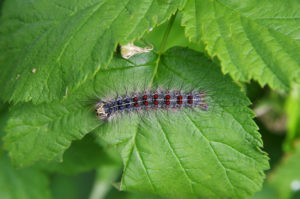 At Maple Hill Tree Services we offer two different biological controls to reduce Lymantria dispar dispar (LDD) populations. Both these treatments target LDD in the larval (caterpillar) stage when they are feeding and defoliating trees, but is one better than the other?
At Maple Hill Tree Services we offer two different biological controls to reduce Lymantria dispar dispar (LDD) populations. Both these treatments target LDD in the larval (caterpillar) stage when they are feeding and defoliating trees, but is one better than the other?
Pesticide Use at Maple Hill Tree Services
Pesticides, insecticides, and fungicides can have negative impacts on the environment if used incorrectly. At Maple Hill Tree Services, it is especially important to us to find the balance between what is required to protect trees and what is the right thing to do for the environment and native species. Therefore, we only use chemical or biological controls as a last resort. Protecting trees and landscapes from invasive species retains important habitats for native plants, animals, and insects.
TreeAzin
TreeAzin is a systemic insecticide produced from Neem tree (Azadiracta indica) seed extracts that is injected directly into the base of trees. TreeAzin is not a neonicotinoid and is not from the avermectin family of pesticides.
TreeAzin Systemic Insecticide – BioForest
At Maple Hill, we have predominantly used TreeAzin to treat against Emerald Ash Borer, but with the surge in LDD populations, we have started to use it to help combat this invasive species.
TreeAzin is delivered via injections, meaning we drill holes into the trunk of the tree and use pressurized canisters to administer the insecticide. The insecticide moves throughout the tree through a process called translocation. Within 48 hours, the insecticide is present in the leaves and is fatal to the larvae as they feed.
Pros
- Injecting insecticide directly into the tree means that there will never be any overspray which minimizes non-target species loss.
- The insecticide lasts the entire season and cannot be washed away by weather events so there is never a reason to reapply.
- We can inject large trees that would be difficult to spray.
- Can be injected in the wind or rain.
- Poses minimal risks to applicators/bystanders, bees and other pollinators, soil and aquatic environments and pets/wildlife.
Cons
- Can be expensive for large properties with many trees
- Targets all species that feed on the leaves including native caterpillars.
- Since holes must be drilled into the trunk, this can not be used on small trees (less than 15cm diameter)
- Cannot be used on trees that flower during or after the larvae stage. The insecticide will be present in the flowers and will kill bees and other pollinators.
Bacillus thuringiensis kurstaki (BTK)
Bacillus thuringiensis subspecies kurstaki, commonly referred to as BTK, is a bacterium found naturally in soils. For some 30 years it has been used successfully worldwide as a biological pest control agent to combat a variety of forestry and agricultural insect pest
Nufarm Canada | DiPel 2X DF | Biological Insecticide | Crop Protection
At Maple Hill, we use BTK to spray small to medium-sized trees to help control LDD populations among other pests.
BTK is applied via foliar or spot spraying. The key is to coat the leaves as best as possible so that the bacteria can be ingested as the larvae feed. Once ingested, the toxins are activated and begin to break down the gut of the caterpillar, eventually leading to death. BTK is also applied by aerial applications for large-scale applications.
Pros
- Suitable for use on other insects including box tree moth.
- Can be used on small trees and ornamentals.
- Not harmful to bees or beneficial insects.
Cons
- Can be washed away by rain and require reapplication.
- Can be applied to unintended plants via overspray or dripping.
- Cannot be used for large trees.
Summary
Both biological controls are highly effective in controlling LDD populations in large shade trees and landscape plants. We will work with you to develop a plan that best fits your property and trees.
It is important to first determine if populations will be significant enough to warrant biological controls. Most trees, especially healthy trees, can handle some defoliation in a season.
For trees that are stressed, the focus should be on improving tree health. This can be done with fertilizers, compost tea, mulch or pruning. Insecticide use may be more necessary in stressed trees to ensure that they are not defoliated causing further stress.
Insecticide use is only one part of an LDD management plan. Other options include egg mass removal, burlap banding, pheromone traps and hand picking. Depending on the degree of the infestation, one or all these techniques may be used in a season. It is always best to consult with an ISA Certified Arborist to determine the best solution for you and your property.